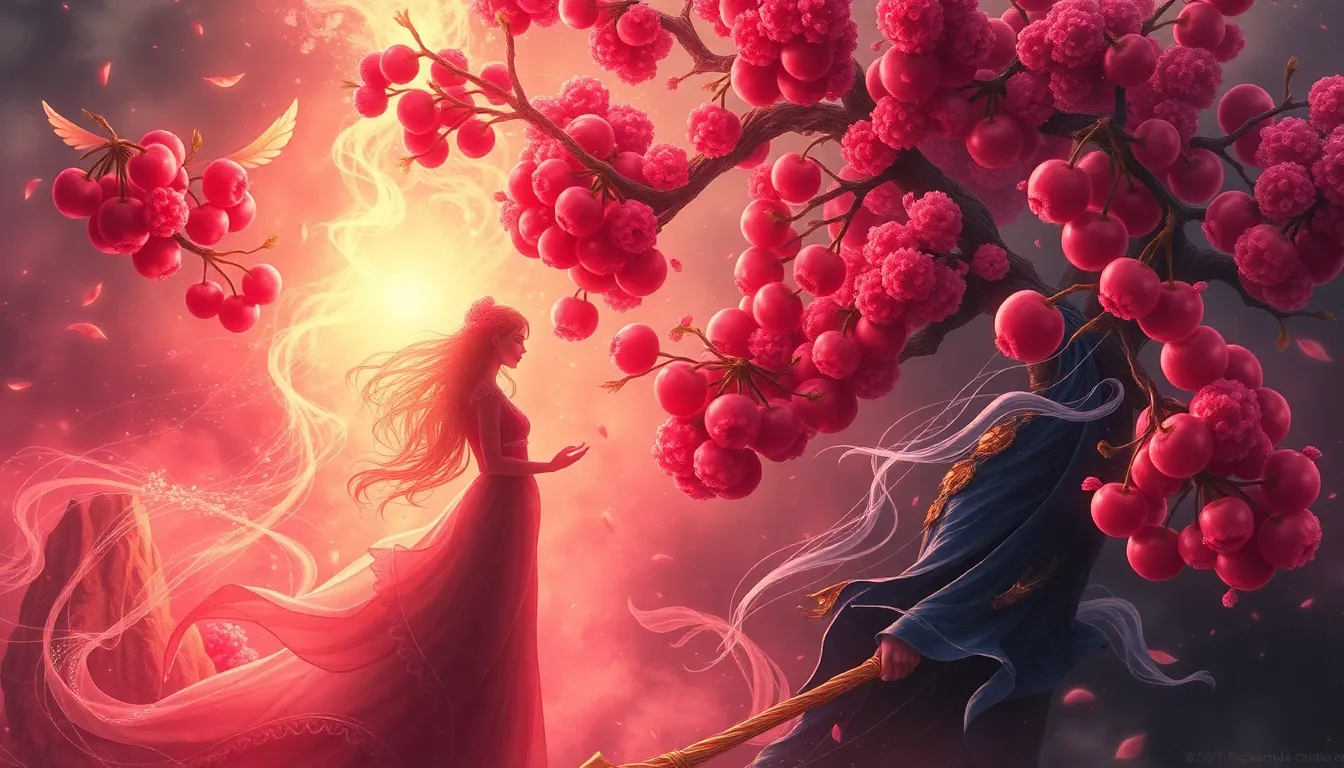The Sacred Cherry: Myths of Love and Rebirth
I. Introduction
The cherry tree, with its delicate blossoms and vibrant fruit, holds a profound place in various cultures around the world. Its beauty not only captivates the eye but also enchants the spirit, making it a symbol of love, renewal, and rebirth. From ancient folklore to modern celebrations, the cherry tree has woven itself into the fabric of human experience, representing the transient nature of life and the enduring power of love.
This article aims to explore the cultural significance of the cherry tree, particularly its association with love and rebirth in mythology. By delving into historical contexts, myths, artistic representations, and contemporary implications, we will uncover the layers of meaning embedded in the sacred cherry blossom.
II. The Cherry Blossom: A Symbol of Love
A. Historical context of cherry blossom symbolism
The symbolism of the cherry blossom has deep historical roots. In ancient cultures, the fleeting beauty of the blossoms, which last only a few weeks, became a metaphor for the ephemeral nature of life and love. This transience evokes a sense of urgency and appreciation for romantic connections.
B. Cherry blossoms in Japanese culture: Hanami and romantic associations
In Japan, cherry blossoms are celebrated during the festival of Hanami, a tradition that dates back centuries. During this time, people gather under blooming cherry trees to share food, laughter, and love. The cherry blossom, or sakura, symbolizes not only beauty but also the bonds of friendship and romance.
- Hanami encourages reflection on the beauty of life.
- It fosters connections among family and friends.
- Romantic encounters during Hanami often blossom, emphasizing the link between love and nature.
C. Comparisons with other cultures’ interpretations of the cherry blossom
While the cherry blossom is most famously associated with Japan, other cultures also recognize its significance:
- In China, cherry blossoms represent feminine beauty and the arrival of spring.
- In Korea, they symbolize the beauty of life and the importance of family ties.
- In Western cultures, cherry blossoms are often associated with spring and new beginnings.
III. Myths and Legends Surrounding the Cherry Tree
A. Ancient tales of cherry trees in different cultures
Many cultures have woven cherry trees into their myths and legends, often highlighting themes of love and rebirth. For instance, in Japanese folklore, it is said that the cherry tree was created by the goddess Konohana Sakuya Hime, who represents the beauty of nature and the transient nature of life.
B. The role of cherry trees in folklore and legends
These trees often appear in tales of romance, sacrifice, and transformation. In various stories, lovers have been transformed into cherry trees to symbolize their eternal bond, showcasing how love can transcend even death.
C. Notable myths that emphasize themes of love and rebirth
One prominent myth involves a young couple who, after facing insurmountable odds, are turned into cherry blossoms. Their love becomes eternal, signifying that true love can blossom again, even in the face of adversity.
IV. The Cherry Tree in Literature and Art
A. Representation of cherry trees in classic literature
Cherry trees have inspired countless writers, symbolizing the beauty and fragility of love. Classic works often depict cherry blossoms as a backdrop for romantic encounters, emphasizing their role in human emotions.
B. Artistic interpretations in painting and sculpture
In art, cherry trees have been immortalized by masters like Claude Monet and Vincent van Gogh, who captured their ethereal beauty. Sculptures often represent cherry trees as symbols of hope and renewal, making them a popular subject in public spaces.
C. Influence of cherry trees on contemporary creative expressions
Today, cherry blossoms continue to inspire artists, musicians, and writers. They symbolize the fleeting moments of beauty in life, reminding us to cherish love and relationships.
V. The Cycle of Life: Cherry Trees and Rebirth
A. The biological lifecycle of cherry trees as a metaphor for rebirth
The life cycle of cherry trees mirrors the themes of rebirth and renewal. They bloom each spring, shedding their flowers only to bear fruit in the summer, symbolizing the cyclical nature of life.
B. Cultural practices and celebrations centered around cherry blossoms
Various cultures celebrate the arrival of spring with festivals honoring cherry blossoms. These events foster a sense of community and renewal, encouraging people to reflect on their lives and relationships.
C. The significance of spring in relation to renewal and love
Spring is often viewed as a time of new beginnings, making it a fitting backdrop for love stories. The blossoming of cherry trees serves as a reminder of the beauty and potential that comes with each new season.
VI. The Spiritual and Religious Significance of the Cherry Tree
A. Cherry trees in spiritual beliefs and rituals
Cherry trees hold spiritual significance in many cultures. In Shintoism, they are revered as sacred and are often associated with various rituals that celebrate nature’s beauty and the cycle of life.
B. Connections between cherry blossoms and various deities
In Japanese mythology, cherry blossoms are connected to several deities, including Konohana Sakuya Hime, who embodies the spirit of flowers and life. Her association with cherry trees emphasizes the divine connection between love, nature, and rebirth.
C. The tree as a symbol of hope and new beginnings
Cherry trees are viewed as symbols of hope in many spiritual practices. Their ability to bloom after winter reflects the resilience of the human spirit and the potential for renewal.
VII. The Cherry Tree in Modern Context
A. The impact of urbanization on cherry tree symbolism
As urbanization increases, cherry trees face challenges, which can impact their symbolism. However, their presence in cities remains a vital reminder of nature’s beauty amidst concrete landscapes.
B. Contemporary celebrations and festivals dedicated to cherry blossoms
Modern festivals, such as the National Cherry Blossom Festival in Washington, D.C., draw millions of visitors and celebrate the enduring significance of cherry blossoms as symbols of love and renewal.
C. Environmental conservation efforts related to cherry trees
Efforts to preserve cherry trees and their ecosystems have gained momentum, as communities recognize their importance in promoting biodiversity and environmental health.
VIII. Cherry Trees as a Catalyst for Personal Reflection
A. The role of nature in personal growth and healing
Nature, particularly cherry trees, can serve as a catalyst for personal reflection and growth. Many people find solace under their branches, allowing for moments of introspection and healing.
B. How cherry trees inspire love, hope, and renewal in individuals
Cherry trees encourage individuals to embrace love, hope, and renewal, reminding them of the beauty that can emerge from difficult times. Their blossoms inspire acts of kindness and connections between people.
C. Personal stories and testimonials related to cherry trees
Many individuals share personal stories of love and renewal linked to cherry trees, illustrating their profound impact on human emotions. These testimonials reveal the deep connections people feel with these sacred trees.
IX. Global Perspectives on Cherry Trees and Their Myths
A. Variations of cherry tree myths across different cultures
Across various cultures, cherry trees are celebrated through unique myths and legends that highlight their significance. These variations showcase the universal themes of love and rebirth.
B. Comparative analysis of love and rebirth narratives across societies
By comparing these narratives, we can see how the cherry tree serves as a bridge between cultures, uniting people under a common understanding of love and renewal.
C. The universal message of the cherry tree in bringing people together
The cherry tree, in all its beauty, serves as a powerful symbol that transcends cultural boundaries, reminding us of our shared experiences of love, loss, and rebirth.
X. Conclusion
In conclusion, the cherry tree is much more than a beautiful plant; it embodies deep cultural significance tied to love and rebirth. Through myths, literature, and art, the cherry blossom has established itself as a timeless symbol of hope and renewal. As we continue to celebrate this sacred tree, we honor the universal themes that connect us all—love, loss, and the potential for new beginnings.


